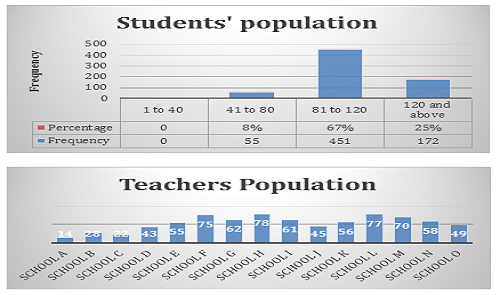
Teachers and Students appraisal of Secondary School as Custodian of Moral Values
Abstract
Keywords
Full Text:
PDFReferences
Aboderin, Y. (2011). Teacher education today. Journal on committee of provost of College of education Nigeria. 1 (4), 65-70.
Adesina, S. (1990). Education management. Fourth Dimension. Enugu: Harper Publishers.
Akinkugbe, O.O.(2014).Nigeria and education: The challenges ahead. Education Legal and Management studies.4, 7-15.
Apeabu, J. A. (2014). Education for all: A look at the school placement program in Nigeria. Zaria Journal of Educational Studies.6, (4), 27-31
Berkowitz, M.W., & Oser, F.(1985). Moral education: Theory and application. Hillsdale, NJ: Lawrence Erlbaum.
Ballantine, J. H. (2015). School and society: A sociological approach to education. (5th Ed.). California: Sage Publication. Inc.
Chianu, E., (2001). Corporal punishment in primary and secondary schools: Legal Position. Asaba: Endless Books Publishers
Colby, R. (1987). Moral education through drama, 2D, 7(1), 72
Durkheim, E. (1968). Moral education. New York: Free Press.
Edmiston, B.(1995).Discovering right actions: forging ethical understandings through dialogic interactions, in P. Taylor& C. Hoepper (Eds)Selected Readings in Drama and Theatre in Education (Brisbane, NADIE Publications).
Fayose, D. E. (2014). Education for character: Alternative to values clarification and cognitive moral development curriculum. The Journal of Educational Thought, 2(2), 67¬- 76
Hansen, A. (2001), The student as moral agent. Journal of Moral Education, 27(2), 179¬-190.
Handel, G., Cahill, S. E., & Elkin, F. (2007). Children and society: The sociology of children and childhood socialization. Los Angeles, CA: Roxbury Publishing Company.
Haralambos, M. & Heald, R.M. (1980). Sociology term and perspectives. Unwin publisher.
Hurn, C. J. (1993). The limits and possibilities of schooling, An introduction to sociology of education. London. Allyn and Bacon, Inc.
Kotaiah (2014). Role of the teacher in development of moral values. International Journal of English Language, Literature and Translation Studies (IJELR). 1(3) 70-73
Macionis, J.J. (1989). Sociology. 2nd Ed. New Jersey: Englewood Cliffy.
Mannheim, M. & Stewart, W. A. C. (1980). An introduction to the sociology of education. London: Routledge and Kegan Paul Limited.
Meighan, R. (1977) Sociology of Educating, 2nd Ed. New Jersey: Prentice- Hall, Englewood Cliffs.
Musgrave, P. W. (1968). The Sociology of Education, London; Cox Wyman Ltd.
Obameata, O. (1995). An appraisal of education and discipline in some selected primary schools in Ilorin Unpublished M.ED. Dissertation, University of Ilorin.
Ottaway, A.K.C. (2010). Durkheim on education. Journal British Journal of Educational Studies16,(1)5-16. Available at: https://doi.org/10.1080/00071005.1968. 9973204
Power, C. F., Higgins, A..& Kohlberg, L. (1989). Lawrence Kohlberg’s approach to moral education. New York: Columbia University Press.
Rigby, K., (2011). Bullying in schools and what to do about it. London: Jessica Kigsley.
Ryan, K. (1986). The new moral education. Phi Delta Kappan, 68 (4), 228- 233. Retrieved from: http: hi-ho.ne.jp/taku77/refer/ryan.htm
Ryan, K., & Bohlin, K. (1999). Building character in schools. San Francisco: Jossey-Bass.
Sanderse, W. (2012).The meaning of role modelling in moral and character education. Journal of Moral Education,42(1),28‐42.
The Research Advisors, (2006), Sample size table. Retrieved from:
http://research-advisors.com.
Winston, J. (1996). Emotion, reason, and moral engagement in drama, Research in Drama Education,1 (2), 189– 200.
Winston, J. (2010). Drama, narrative and m oral Education: exploring traditional tales in the primary years (London, Falmer)
Williams, D. D., Yanchar, S. C., Jensen, L. C. & Lewis, C. (2003). Character education in a public high school: a multi-year inquiry into Unified Studies. Journal of Moral Education, 32(1), 3–34.
DOI: http://dx.doi.org/10.31258/jes.5.4.p.638-651
Refbacks
- There are currently no refbacks.
Copyright (c) 2021 BELLO Bolanle Muhinat

This work is licensed under a Creative Commons Attribution 4.0 International License.
Publisher: FKIP Universitas Riau













